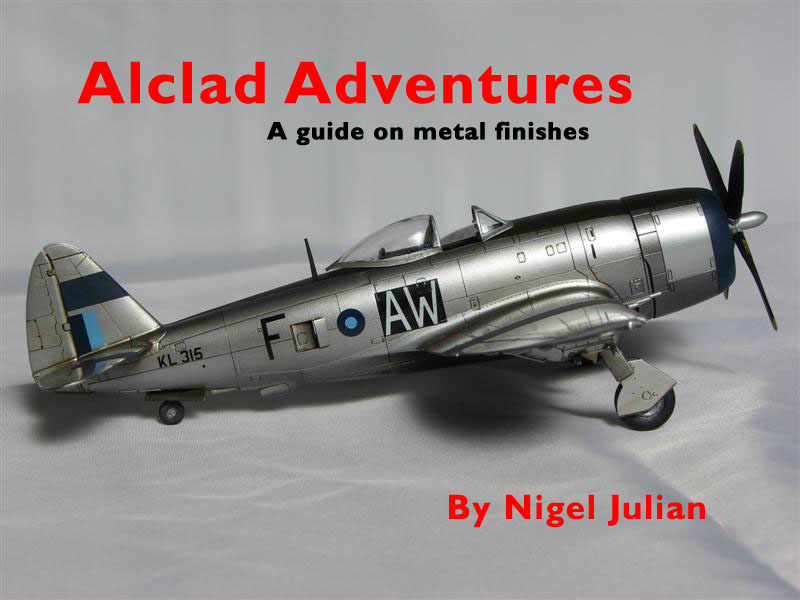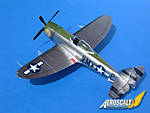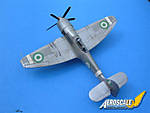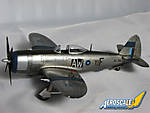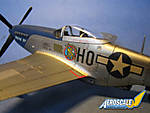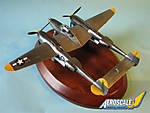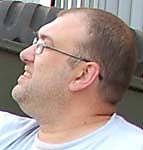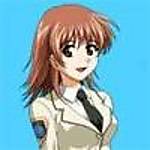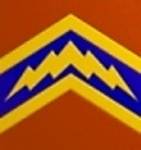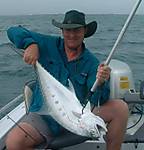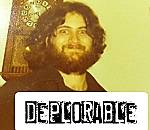Alclad Adventures
19
Comments
Metal finish
Some of the most eye catching models seen on display are the ones painted with a bare metal finish (BMF), also abbreviated to NMF (Natural Metal Finish).USAAF fighters and bombers of WW2 are common subjects, and a BMF is also very popular amongst jet modellers.
Silver paint finishes have a reputation of being notoriously hard to achieve good results with, and this has served to put off many modellers from attempting one. Indeed, a comment often seen in the forums on Aeroscale goes along the lines of “ I’ve tried a NMF before but never managed to finish one”.
The idea behind this feature began with a PM from a member asking me for advice on natural metal finishes. Rather than replying in the private message domain I decided to turn the answer into a short article.
Over the last couple of years I’ve built 5 aircraft with natural metal finishes. Each one has been finished using Alclad2 lacquer.
Alclads website can be found here.
http://www.alclad2.com/alclad-home.html
In no way should this feature be considered, and neither is it intended to be, an attempt to be a definitive guide to producing a NMF.
What I hope to do is dispel some of the fear and trepidation that many people acquire at the very mention of modelling a BMF scheme aircraft, and to share what methods and techniques I have found work best for me.
When modelling a subject with a NMF one thing will be immediately apparent. Any seams, glue marks, scratches, sanding marks, finger prints will be magnified many times over when Alclad2 is applied. While many people will see this as a bad thing, I prefer to look at it the other way. I see this as a way of working on and improving basic building skills. If you can get your seams to look good with a NMF over the top of them then they are going to look good every time!
So, as this is an article aimed at explaining how I go about actually painting a model in a BMF, lets assume that all the seams are perfectly finished and sanded smooth. No glue marks remain and the model has been washed (I use Isopropyl alcohol) to remove any grease, oil and fingerprints.
Comments
Thanks Nigel I will have to give that a try when I get round to the 1/24 Mustang. be prepared for more questions
JUL 20, 2008 - 07:14 PM
This may help...
Here's some scans of the instructions that I got wrapped round a bottle of Alclad once.
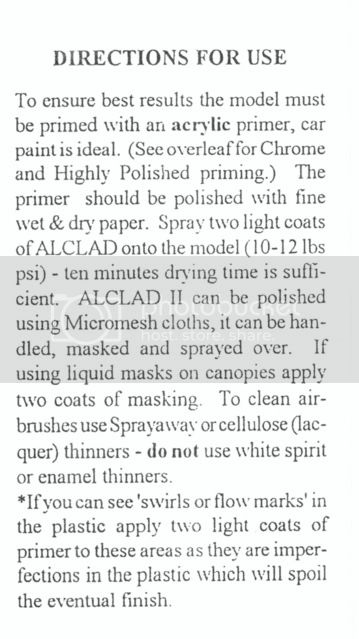
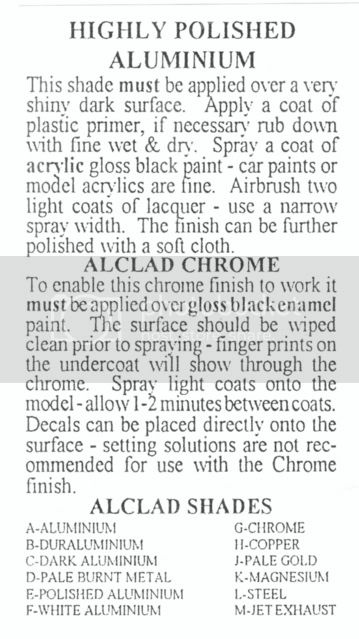 Cheers
Allen
Cheers
Allen

 Cheers
Allen
Cheers
AllenAUG 09, 2008 - 08:15 AM
Oh boy did I just screw it up... used the alclad and everything went fine and dandy then used a bit of mm plate alum. and the world blew up it crazed. well I think it is salvageable but for now this superbolt is back in the box .... what a bummer this day became. live and learn i guess
Kelly
NOV 25, 2008 - 06:32 AM
Hmmm I never knew you used alcohol to clean your airbrush after using Alclad.. Might give it a go now.
Thanks Nige
SEP 25, 2011 - 10:46 AM
Hi Warren.
Yep, Isoproyl alcohol works a treat.
I also use it if I need to strip a panel and repaint.
Mask off the area along the nearest convenient panel lines using Tamiya tape, and very gently rub at the paint using a cotton bud/Q-tip just dampened with isopropyl.
At the edges, swipe from the masking tape onto the area being stripped and not the other way round. This way you don't force isopropyl under the masking tape.
On this P-47, most of both wings and a section of the starboard fusalage were stripped (as far onto the build as the decal stage) amongst many other individual panels, and repainted.
A bit scary the first time you attempt it but once you've done it a couple of times you get used to it.
 Hope this helps
Nige
Hope this helps
Nige
SEP 25, 2011 - 09:45 PM
Nigel, really enjoyed your article on NMFs. Just loaded with sound, basic methods, and advice.
Joel
JUL 24, 2013 - 02:36 AM
I can confirm the alclad black primer is bad news - didn't ever cure in my case either.
And for what it is worth, I have used the tamiya spray bottle gloss black as a primer layer (which is a lacquer base, not acrylic) under alclad metallics with good success - but you do have to keep the alclad coats very light and build up in coats, as nigel said, or the alclad might attack the lacquer (hasn't happened to me yet tho).
JUL 24, 2013 - 03:52 AM
I'm glad this thread has been bumped up again, I hope it encourages a few more folks to try the NMF schemes.
I always use Tamiya black semi-gloss acrylic as my Alclad primer and have never had any problems. I also mask and spray the anti glare panels and stripes over the Alclad after just an hour or so drying, usually using "post-it notes" as the masking, they are extremely low-tack and never lift the paint underneath.
Cheers, D
JUL 24, 2013 - 10:27 AM
Blimey, is it really over 5 years since I wrote this article??
It takes me almost that long to finish a model these days!
Really glad that all this time afterwards it's still encouraging people to give a nmf a go
Cheers,
Nige
JUL 24, 2013 - 01:45 PM
You have no idea how much encouragement that article did for me. I will now face painting my bubble top with far less fear than I had before.
Thanks Nigel, Joel and Jessica for all the advice you guys give so generously.
OCT 07, 2016 - 03:59 PM
Copyright ©2021 by Nigel Julian. Images also by copyright holder unless otherwise noted. The views and opinions expressed herein are solely the views and opinions of the authors and/or contributors to this Web site and do not necessarily represent the views and/or opinions of AeroScale, KitMaker Network, or Silver Star Enterrpises. Images also by copyright holder unless otherwise noted. Opinions expressed are those of the author(s) and not necessarily those of AeroScale. All rights reserved. Originally published on: 2008-05-31 00:00:00. Unique Reads: 19438




